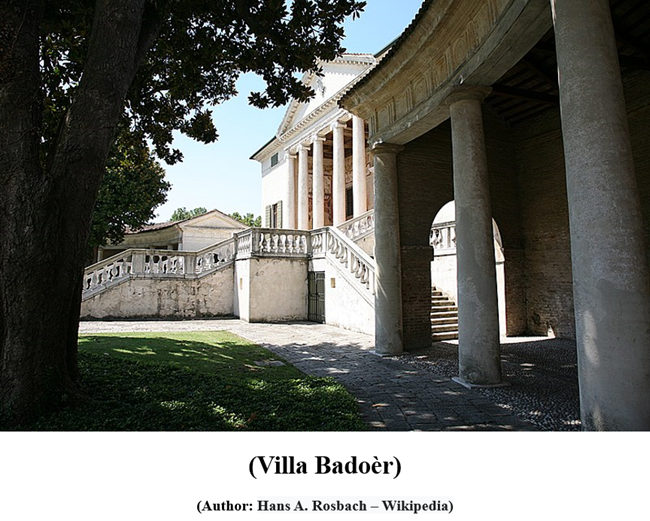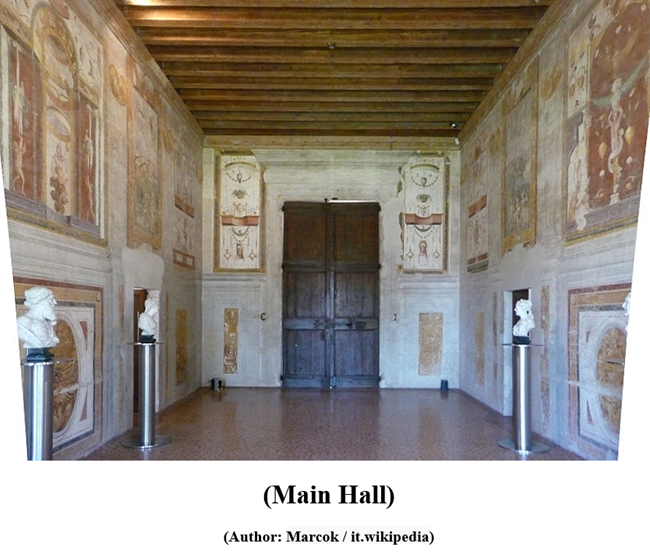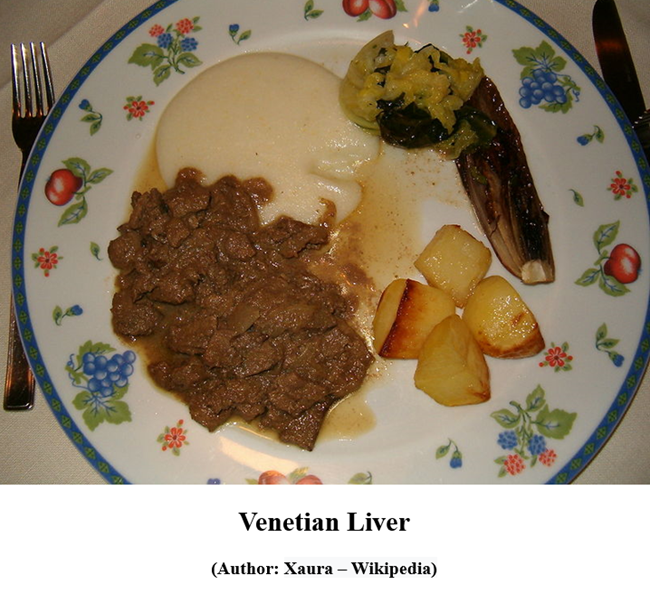Meravigliosa Italia: Villa Badoer & Fegato alla Veneziana / Amazing Italy: Visiting Villa Badoèr

Ringrazio M. Teresa De Donato per aver pubblicato la nostra intervista sulla rivista Idea Magazine - nuovo periodico on line degli italiani negli USA.
Buona lettura a tutti.
https://lideamagazine.com/meravigliosa-italia-villa-badoer-fegato-alla-veneziana/
----------------------------------
Amici carissimi oggi continuiamo a viaggiare nella nostra Meravigliosa Italia con l’amica e collega Maria Cristina, Autrice e Blogger.
Maria Cristina ha partecipato molto attivamente, insieme ad altri
colleghi ed amici, a questa mia Rubrica e invito voi tutti a leggere gli
altri articoli per farvi ispirare dalle varie località che sono state
presentate nonché dalle apprezzatissime ricette che potrete gustare
visitando soprattutto il suo territorio. Di recente ha iniziato a
presentarci le Ville Venete, alcune delle quali furono progettate e realizzate dal famoso architetto Andrea Palladio.
Oggi ne prenderemo in considerazione una in particolare: Villa Badoèr
Auguro a voi tutti una buona lettura!
MTDD/L’Idea: Ciao Maria Cristina e benvenuta di nuovo a questo Salotto Culturale Virtuale.
MCB:Grazie a te, Maria Teresa, per il tuo invito.
MTDD/L’Idea: Come ho appena accennato, oggi ci
porterai, anche se solo virtualmente, a visitare una delle Ville Venete e
precisamente Villa Badoèr. Cosa puoi dirci di questa Villa?
MCB: Villa Badoèr, detta “La Badoèra”, si trova a
Fratta Polesine (un comune poco distante da Rovigo); è stata progettata
dall’architetto Andrea Palladio nel 1554-1555 circa su commissione di Francesco Badoèr, discendente
di un’illustre famiglia della Serenissima. L’edificio, assieme ad
altre ville palladiane del Veneto, è inserito dal 1996 nella lista dei
Patrimoni dell’Umanità dell’Unesco.
MTDD/L’Idea: Ci fu un motivo specifico per cui fu fatta costruire questa Villa?a:
MCB: Sì. In quel periodo storico,
l’aristocrazia veneziana aveva cominciato a preferire l’entroterra per
favorire i propri investimenti, spesso derivati dai redditi mercantili.
Le Ville Venete diventarono così un simbolo di questo loro “mondo”.
Francesco Badoèr voleva un presidio dal quale amministrare la proprietà e mostrare il suo status sociale ed economico.
MTDD/L’Idea: Quali sono le caratteristiche principali di questa Villa?
MCB: L’edificio si trova sopra un antico castello
medievale. La facciata principale richiama l’armonia dei templi greci,
con il timpano triangolare e il colonnato d’ordine ionico raggiungibile
attraverso la scalinata.
Le barchesse disposte a semicerchio sono un esempio unico nel loro
genere tra le ville palladiane, hanno forme curve e, insieme al
colonnato in stile tuscanico, accolgono il visitatore.
Da notare che il pronao e il piano nobile hanno affreschi con scene allegoriche, pastorali, mitologiche e a tratti grottesche e sono opera del pittore Giallo Fiorentino.
È la prima villa in cui l’architetto padovano utilizzò interamente un
pronao con frontone in facciata, ed è anche l’unica realizzata in
territorio polesano.
Chi desiderasse avere ulteriori informazioni su questa Villa potrà farlo visitando i seguenti siti:
http://www.villevenete.net/tutte_le_ville/villa_badoer_detta_la_badoera/
https://it.wikipedia.org/wiki/Villa_Badoer
https://www.beniculturalionline.it/location-1826_Villa-Badoer.php
https://www.culturaveneto.it/it/beni-culturali/ville-venete/6494af48b282ae2b52bb4885
MTDD/L’Idea: Molto affascinante anche questa
Villa. Grazie, Maria Cristina, per le tue ricerche e per presentarci
sempre attrattive così interessanti da un punto di vista artistico,
culturale, storico ed architettonico.
Concludiamo anche oggi la nostra intervista con una tua ricetta locale?
MCB: Certamente! Oggi vi propongo il Fegato alla Veneziana.
Ricetta
Fegato alla veneziana
Si tratta di un piatto tipico veneto semplice e gustoso, che una
volta era per i poveri e oggi è un piatto ricercato con diverse
varianti.
Una volta si usava per lo più il fegato di maiale, ma potete usare anche quello di vitello o vitellone, entrambi più teneri.
Per 500 gr. di fegato utilizzare 400 gr. di cipolla bianca tritata molto
fine, una manciata di prezzemolo tritato anche lui, (se non ricordo
male mia mamma non lo usava). Mettere sul fuoco un tegame con olio e
un po’ di burro (mia madre non usava neanche il burro). Quando l’olio è
caldo aggiungere il trito, farlo rosolare e continuarne lentamente la
cottura a fuoco basso, aggiungendo un po’ d’acqua e tenendo il tegame
chiuso da un coperto fino a che la cipolla non sia stufata. Controllare
la cottura per evitare che il trito con la cipolla si bruci. Mettete
poi, nel tegame le fettine di fegato infarinate, rigiratele e aggiungete
– se serve ancora – un po’ di acqua calda per continuarne la cottura
fino alla fine, bastano pochi minuti circa 5 o 10. Assaggiate per
accertarvi se dovete aggiungere sale e pepe e poi servite con purè o
polenta o pane riscaldato.
Buon appetito!
Il presente articolo è stato pubblicato anche al seguente link
Amazing Italy: Visiting Villa Badoèr with Maria Cristina Buoso
by Maria Teresa De Donato (Article previously published)
Dear friends, today we continue to travel in our Amazing Italy with our friend and colleague Maria Cristina, Author and Blogger.
Maria Cristina participated very actively, together with other
colleagues and friends, in this Column of mine, and I invite you all to
read the other articles to be inspired by the various locations that
have been presented as well as by the highly appreciated recipes that
you can enjoy by visiting especially her territory. She recently started
introducing us to the Venetian Villas, some of which were designed and built by the famous architect Andrea Palladio.
Today, we will be considering one in particular: Villa Badoèr.
Enjoy the reading!
MTDD/L’Idea: Hi, Maria Cristina, and welcome again to my Virtual Cultural Salon.
MCB: Thank you, Maria Teresa, for your invitation.
MTDD/L’Idea: As I just mentioned, today, you will be taking us, even if only virtually, to visit one of the Venetian Villas, specifically Villa Badoèr. What can you tell us about this Villa?
MCB: Villa Badoèr, also known as “La Badoèra,”
is located in Fratta Polesine (a municipality not far from Rovigo). It
was designed by the architect Andrea Palladio around 1554-1555 and
commissioned by Francesco Badoèr, a descendant of an illustrious family
of the Serenissima. The building and other Palladian Villas in the
Veneto have been included in the list of UNESCO World Heritage Sites
since 1996.
MTDD/L’Idea: Was there a specific reason why this Villa was built?
MCB: Yes, there was. In that historical period, the
Venetian aristocracy had begun to prefer the hinterland to encourage
their investments, often derived from mercantile income. The Venetian
Villas thus became a symbol of their “world.” Francesco Badoèr wanted a
garrison to administer the property and demonstrate his social and
economic status.
MTDD/L’Idea: What are this Villa’s main features?
MCB: The building is located above an ancient medieval
castle. The main facade recalls the harmony of Greek temples, with the
triangular tympanum and the Ionic order colonnade reachable via the
staircase. The barchesse arranged in a semicircle are a unique example
of their kind among Palladian Villas; they have curved shapes and,
together with the Tuscan-style colonnade, welcome the visitor. It should
be noted that the pronaos and the main floor have frescoes
with allegorical, pastoral, mythological, and sometimes grotesque
scenes, which are the work of the painter Giallo Fiorentino.
It is the first Villa in which the Paduan architect entirely used a
pronaos with a pediment on the facade, and it is also the only one built
in the Polesine area.
Anyone wishing to have further information on this Villa may want to visit the following sites:
http://www.villevenete.net/tutte_le_ville/villa_badoer_detta_la_badoera/
https://it.wikipedia.org/wiki/Villa_Badoer
https://www.beniculturalionline.it/location-1826_Villa-Badoer.php
https://www.culturaveneto.it/it/beni-culturali/ville-venete/6494af48b282ae2b52bb4885
MTDD/L’Idea: This Villa is also very
fascinating. Thank you, Maria Cristina, for your research and for always
presenting us with such exciting attractions from an artistic,
cultural, historical, and architectural point of view. Let’s conclude
our interview today with one of your local recipes, shall we?
MCB: Of course! Today, I propose Venetian Style Liver.
Recipe
Venetian Style Liver
This is a simple yet tasty typical Venetian dish, which was once for
poor people, although today, it is a refined dish with different
variations. Once upon a time, pork liver was mainly used, but you can
also use calf or beef liver, which are more tender. For 500 gr. of
liver, use 400 gr. of very finely chopped white onion and a handful of
chopped parsley, too (if I remember correctly, my mother didn’t use it).
Place a pan with oil and a little butter on the heat (my mother didn’t
use butter either). When the oil is hot, add the chopped mixture, brown
it, and continue cooking slowly over low heat, adding a little water,
and keep the pan covered with a lid until the onion is stewed. Check the
cooking to prevent the chopped onion from burning.
Then place the floured liver slices in the pan, turn them over, and add –
if needed – a little more hot water to continue cooking until the end; a
few minutes, from 5 to 10, are enough. Taste to ensure the quantity of
salt and pepper you use is enough, then serve with mashed potatoes,
polenta, or reheated bread.
Enjoy your meal!
Commenti
Posta un commento